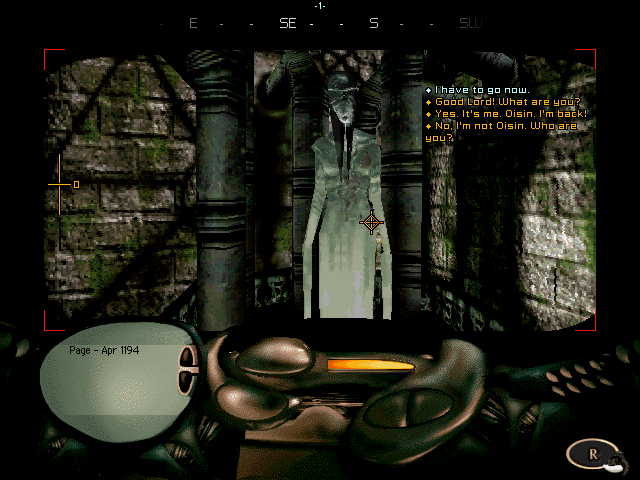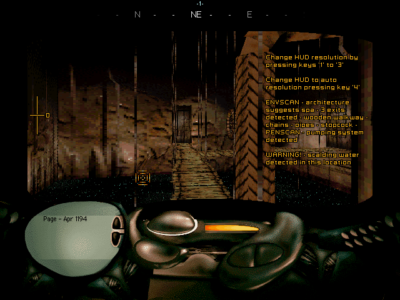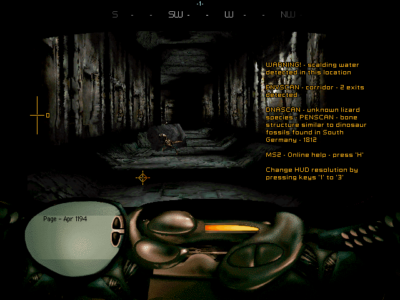
Azrael’s Tear
Written by: Stoo
Date posted: June 10, 2001
- Genre: Adventure
- Developed by: Intelligent Games
- Published by: Mindscape
- Year released: 1996
- Our score: 9
Here’s one to file away in the list of great games that nobody noticed: Azrael’s Tear, one of the most fascinating adventure games ever, which sold about four copies on the entire planet and then quietly disappeared. This could be my cue for a rant about how some really impressive items in gaming history have gone unrewarded, whilst the gaming public gleefully forked out their cash on yet more Tomb Raider titles, but I’ll save that for another day.
Anyway, the story is this: you’re a high-tech thief in the near-future who has found the ruins of an ancient underground temple complex in Scotland, which has laid there undisturbed since medieval times. Rumour has it that the holy grail has been stashed down here for centuries, and if retrieved it could be the key to curing a plague currently ravaging humanity, and thus a key to great rewards for yourself.
However, soon after breaking into a chamber near the surface you find that Aeternis, as it’s called, isn’t quite deserted. In fact it’s still populated by the survivors of a group of Knights Templar entrusted with the sacred task of guarding the grail. They’ve been down here since the fourteenth century, their lives having been somehow immensely prolonged by a substance they call ‘grailstone’ embedded in the bedrock. Apparently the knights will let you have the grail, if you pass their great test, i.e. make your way in one piece through the traps, perils and ferocious creatures that are scattered between the uppermost tunnels and the Grail itself. Beware though, because the centuries under the effects of grailstone have warped the minds and bodies of the Templars, and they’re not all the noble and goodly men they once were.
Your first impression of Azrael’s Tear might be that it looks like one of the more cerebral 1st-person shooters, akin to the likes of System Shock. You’ll soon find though that this is something a bit different and really quite rare – more an adventure game that happens to be in 1st-person than a shooter of any kind. You carry a rifle, but it’s possible to complete the game without firing more than a couple of rounds. It still pays to be alert, because a violent happening can often be just around the corner and a single bullet or blow from an axe can kill, but you’ll be spending far more time exploring, talking and puzzle-solving than fighting things. Basically your gun is just another tool you that you may need to use, when the need to defend yourself arises. Overall it’s an interesting approach to making a game; it’s nice to see that some developers realise a first person game doesn’t have to be action-oriented. Another way of looking at is is: Azrael’s could be thought of as something akin to Myst, except having a proper 3d engine will full freedom of motion.
Anyhow, one of the first aspects of the game to impress me was the environment in which it takes place. If Aeternis actually existed in real life, it would be a fascinating place to explore. The work done in creating a hidden medieval temple-complex has paid off with impressive results, with dank tunnels, dusty disused workshops and lofty chambers. You get an impression of how Aeternis was once maybe a vibrant little world of its own, but has over the years become a gloomy, lonely place. There’s a wonderfully old and grimy feel to it, similar to some of the locations in Thief. Visit the intricately decorated but crumbling cathedral for some real ambience, or maybe the rotting and forgotten docks. Despite the game looking its age, with some fairly muddy textures, it’s still an excellent example of an immersive environment in a game.
Aside from this, the other main element that makes this adventure so convincing is your interaction with the few surviving denizens of Aeternis, who scuttle furtively about its tunnels. You learn of the Knights’ mission, their story over the years, and their current thoughts on the Grail and opinions of one another. Much of their present alignment and attitude is due to a schism in their ranks centuries before, when one took up worshipping a pagan god, conducted horrific grailstone experiments and led several of his fellows astray. What we have here some of the best storytelling I’ve ever seen in a game – each character has become warped in their own way, twisted by centuries of life underground with the effects of isolation grailstone. In fact, they can’t even die properly; you’ll see one or two horrors wondering around that are a testament to this. Various texts and letters you can pick up provide further details of the rich tale of medieval conspiracies and betrayal. As you learn about the characters, you may find yourself picking any one over the others as the person with whom your sympathies lie, but be prepared to have your view of each one challenged as more of their background and motivation is revealed.
Of course, this being an adventure, so there is some puzzle solving and it always helps to pay attention to what people say and to any written notes you find. The puzzles often take the form of trying to get some piece of machinery to work, and also finding four shields which are keys to accessing deeper portions of the labyrinth. There’s often more than one way to accomplish some tasks, and there’s at least three paths to endings of the game. You’ll probably have to play through a couple of times to find all the rooms, and find a chance to talk to each character. The game overall isn’t actually all that huge, but you have to look very closely to see each path and opportunity.
As well as a some nasty traps, there are a few nasty dinosaur-like monsters prowling the lower reaches of Aeternis. The really big ones, looking like a Tyrannosaurus with no eyes, can be pretty scary. A few can be killed off with your gun, but not all, and the game often provides another means of dealing with them if you loook hard enough. There are also some little scorpion-like critters that are pretty lethal and damn annoying to try and shoot, but again you’re really supposed to avoid them, not get caught up in a firefight.
There’s just one one slightly unconvincing aspect to the game that deserves mention – it must pause to load each room or chamber individually. As a fairly flimsy attempt to cover the issue there’s some on-screen blurb about your hi-tech suit’s on-board scanners probing the area. It’s not a huge issue but can damage the feeling of immersion a little because, if a person or monster is chasing you, they never follow you to another room.
It should also be noted that, while this was a pretty attractive looking game in 1996, the engine wasn’t built for speed. In all fairness, it would have sucked horribly if used to power any kind of shooter. On the hardware of the time it could be frustratingly slow and jerky; I found it pretty clunky on a Pentium 90. This could be especially annoying on the moments where some amount of reflexes or quick action are required, even if such events are fairly rare. Then again, this of course isn’t much of an issue today.
So there you have it, my little account of why Azrael’s Tear is a classic adventure. The way this game seemed to completely fail to gain any notice is thus a bit of a shame. Even enthusiastic reviews from the likes of PC Zone didn’t seem to help much. It’s an well-crafted and thoughtful gaming experience, and you’d think there would be a market for such a thing amongst the more grown-up side of the gaming community. Then again, it was hardly well-publicised. I imagine that, sadly, a lot of adventure fans who might have loved this game were probably put off by its first-person nature, and mistook it for a Doom-clone instead of a ‘proper’ adventure. I suppose that’s a risk of trying to do something a little different, especially when the publicity given to the game amounted to virtually nothing. Still, if I can convince just a couple of readers to hunt this game down and give a try, then my work here is done.




 Posts
Posts